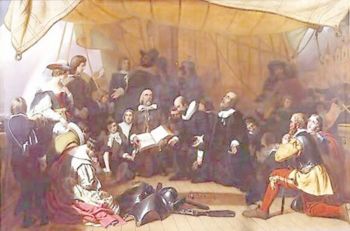CZ:Featured article/Current
Plymouth Colony
by Richard Jensen, Gareth Leng, Robert W King, and Aleksander Stos
Plymouth Colony was an English colony in North America from 1620 until 1691, when it was absorbed by its much larger neighbor, Massachusetts. At its height, the colony occupied most of the southeastern portion of the modern state of Massachusetts.
Founded by a group of separatists who later came to be known as the Pilgrims, Plymouth Colony was, along with Jamestown, Virginia, one of the earliest colonies to be founded by the English in North America and the first sizable permanent English settlement in New England. The colony agreed on a treaty with Chief Massasoit which helped to ensure the colony's success. The colony played a central role in King Phillip's War, one of the earliest and bloodiest of the Indian Wars.
Plymouth holds a unique role in American history as the beginnings of the nation's democratic culture through the Mayflower Compact. Rather than a commercial venture like Jamestown, its citizens sought freedom from religious persecution and a place to settle and worship God in a way they saw fit. The social and legal systems of the colony were closely tied to strong religious beliefs.
Many of the anecdotes and events surrounding Plymouth Colony have become part of American identity, including the tradition of Thanksgiving and the monument at Plymouth Rock. Despite the colony's relatively short history, it has become an important clue to what is "American."
History
Origins
Plymouth Colony was founded by permanent settlers who later came to be known as the "Pilgrims". The core group — roughly 40% of the adults and 56% of the family groupings was a congregation of religious separatists led by pastor John Robinson, church elder William Brewster, and William Bradford (1590-1657). While still in the town of Scrooby in Nottinghamshire, England, the congregation began to feel the pressures of religious persecution. In the Hampton Court Conference, King James I declared Puritans and Protestant Separatists to be undesirables, and in 1607, the Bishop of York raided the homes of and imprisoned several members of the congregation in a prison in Boston, Lincolnshire. The congregation left England and settled the Netherlands, first in Amsterdam, and finally in Leiden in 1609.
In Leiden, the congregation found the freedom to worship as it chose, but Dutch society was unfamiliar to these immigrants. Scrooby had been an agricultural village, whereas Leiden was a thriving industrial center. More serious was their children began adopting Dutch customs and language. Finally, the Pilgrims were not free from the persecutions of the English Crown; after William Brewster in 1618 published comments highly critical of the King of England and the Anglican Church, English authorities came to Leiden to arrest him. Though Brewster escaped arrest, the events motivated the congregation to move even further from England.
In 1619, the Pilgrims obtained a land patent from the London Virginia Company, allowing them to settle at the mouth of the Hudson River. They obtained financing -- a loan--through the "Merchant Adventurers," a group of Puritan businessmen who viewed colonization as a means of both spreading their religion and making a profit. Upon arrival in America, the Pilgrims would then work to repay their debts. Using the money from the Merchant Adventurers, the Pilgrims bought provisions and obtained passage on two ships, the Mayflower and the Speedwell. After some delays the Pilgrims finally boarded the Speedwell in July 1620 from the Dutch port of Delfshaven.
Mayflower voyage
The Mayflower arrived in Southampton, England to rendezvous with the Speedwell and to pick up supplies and additional passengers. Among the passengers to join the group in Southampton were several Pilgrims including William Brewster, who had been in hiding for the better part of a year, and a group of passengers known to the Pilgrims as "The Strangers". This group was largely made up of passengers recruited by the Merchant Adventurers to provide governance for the colony as well as additional hands to work for the colony's ventures. Among the Strangers were Miles Standish (1584-1656), who became the colony's military leader. Characterized in Longfellow's poem as a shy and diffident person and suitor, Standish in reality was a pugnacious, touchy, short-tempered, and aggressive professional soldier. Also included were Christopher Martin, who had been designated by the Merchant Adventurers to act as Governor for the duration of the trans-Atlantic trip, and Stephen Hopkins, a veteran of a failed colonial venture to Bermuda. 120 passengers, ninety on the Mayflower and thirty on the Speedwell, finally departed on August 15. The Speedwell proved unseaworthy; some passengers went home; most crowded onto the "Mayflower." With 102 settlers, it left Plymouth on September 6, 1620. The voyage took almost two months as it was drawn out by strong westerly winds and by the Gulf Stream. Land was sighted on November 9 off the coast of Cape Cod and with winter approaching and provisions running dangerously low, the passengers decided to return north and abandon their original plans to land sat the mouth of the Hudson River.
